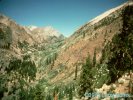 Carl Purpus, Plant Collector in
Western America
Carl Purpus, Plant Collector in
Western America 
Carl A. Purpus Translation by Barbara
Ertter






|
Original Title Bericht uber meine diesjahrige Sammeltour durch die sudostliche Sierra Nevada von Californien Von C. A. Purpus. Daunt Tulare Co. Calif. Mitt. Deutsch. Dendrol. Ges. 5: 229-235.
|
Locations: Little Kern River.
After about ten days, during which several mountain peaks were ascended, we continued our
travels. For my next base camp I selected the headwaters of the Little Kern River, a botanically very interesting forested region, interrupted by meadows and clearings. The forest consisted of the aforementioned conifers with the exception of Pinus balfouriana. The shrubs remained the same ones. Associated on the stony slopes were Artemisia tridentata Pursh, miscellaneous Bigelowia that were new to me, the beautiful subshrubby Penstemon bridgesii A. Gray covered with scarlet flowers, and Tetradymia canescens, an extremely interesting shrub with silvery foliage and golden yellow flowers. Solitary Juniperus occidentalis occurred at about 8500 feet, forming treees that were not very tall but quite thickly branched. In Germany, however, it should be cultivated for its superior wood and because it makes few demands on the soil. It is found here in association with Abies magnifica and Pinus murrayana, while at lower elevations it is joined by Pinus jeffreyi.
|
|  Looking toward Broder Cabin and Farewell Gap, Sierra Nevada, California.
Looking toward Broder Cabin and Farewell Gap, Sierra Nevada, California.
Locations: Farewell Gap.
On somewhat damp, stony ground in a ravine, I encountered a Ribes sp. in the Grossularia group with more or less softly haired leaves and beautiful yellow flowers. I later saw that it bore lovely, delicious, dark red berries the size and color of currants. I also found different varieties of Bigelowia graveolens, a Symphoricarpos with blue-gray leaves, a low Rhamnus on rocks, a lovely subshrubby Eriogonum, Penstemon bridgesii, and Ribes cereum. I found an interesting form of this last shrub with leaves completely covered with a white coating on limestone outcrops at nearly 12,000 feet on the mountain above Farewell Gap. With the exception of Spiraea dumosus, it is the shrub that reaches the highest altitude in this part of the Sierra. At treeline and on up to over 11,000 feet, I encountered the splendid Bryanthus breweri and the interesting Tanacetum canum, first between rocks and on stony, somewhat moist slopes, later on slaty soil. Penstemon newberryi, probably the most beautiful suffructicose species in the Sierra, grew on rocks ascending to over 10,000 feet elevation. Artemisia tridentata is abundant here to nearly 10,000 feet. Dwarfed specimens of Juniperus occidentalis also occur here, as do Pinus balfouriana and P. flexilis James, both of which contribute to the sparse alpine forest.
|
| Locations: Little Kern River. Lyon Meadows. After a fortnight's stay, we went
further down the valley along the Little Kern River, whose banks were bordered by Populus trichocarpa, down to Lyon Meadows, whose lovely grassy flats were surrounded by Pinus jeffreyi and Abies concolor. Pinus jeffreyi attains a height of 60-80 feet here and looks so much like P. ponderosa that, without the cones, one is easily mistaken for the other. The shrubs here included Arctostaphylos sp., Ceanothus pinetorum, an occasional Purshia tridentata DC., which is not a common shrub here, Tetradymia canescens, and, on the cliffs, Haplopappus cuneatus A. Gray, which resembled a Sedum.
|
|  Trout Meadows, southern Sierra Nevada, California.
Trout Meadows, southern Sierra Nevada, California.
Locations: Trout Meadows. We left Lyon Meadows
one fine morning after a violent thunderstorm, enroute to Trout Meadows, where we remained for several days, enduring a powerful hail storm. More Juniperus occidentalis occurred on the slopes of the mountains, along with Purshia tridentata and miscellaneous small shrubby Compositae.
|
| Locations: Kern River Lakes. A few
days later we found ourselves on the Kern River lakes, which spread out on the left bank of the river. Splendid specimens of Populus trichocarpa grew along the river. The shrubs included Sambucus glauca, Garrya sp., Purshia tridentata, and a Rhamnus sp. I also saw several specimens of Pinus monophylla Torr. & Frem., which occurs only on the east side of the Sierra. It had probably been accidentally planted here by Indians, who collect and eat the seeds.
|
| Locations: Volcano Falls. Whitney Creek.
After a short halt, we crossed the swollen Kern River at a shallow spot and headed eastward up
the mountains along Whitney Creek [this would have to be what is now called Golden Trout Creek]. The dominant tree here was Pinus jeffreyi. At 8-9000 feet it gave way to P. murrayana, which is almost the only component of the alpine zone forests, where it advances on P. balfouriana. The understory, very sparse here, consists of Ribes cereum, Symphoricarpos sp., a revolute-leaved form of Bigelovia graveolens, and Artemisia tridentata. On the extinct craters that were prominent along the creek [near Volcano Falls?], I encountered marvelous specimens of Juniperus occidentalis of considerable circumference, as well as Pinus flexilis and P. balfouriana. Along with the shrubs already named, on the rocks grew Gutierrezia sp., Bigelowia, Tetradymia, Spiraea dumosa, and the subshrub Jamesia americana. Farther to the east, Cercocarpus ledifolius Nutt. appeared in abundance as small, gnarled, loose trees or shrubs.
| |
[Previous Page] [Next Page] | |
| [Published Biographies] [Travelogues and Articles] [Letters] [Plant Lists and Bibliography] [Site Administration] | | Date and time this article was prepared: 6/7/2002 7:32:08 PM |